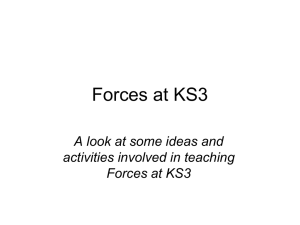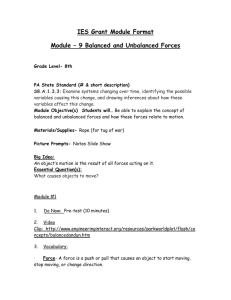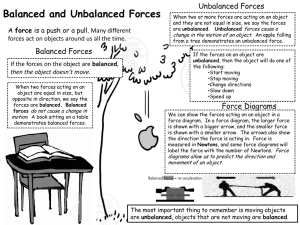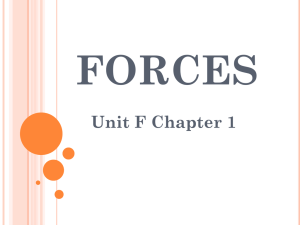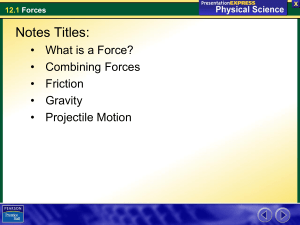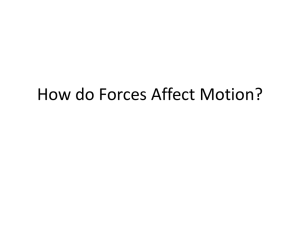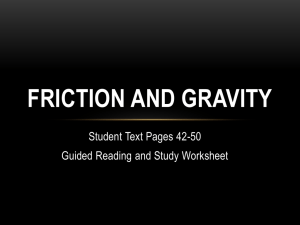Chapter 19-2 Notes - Kawameeh Middle School
advertisement
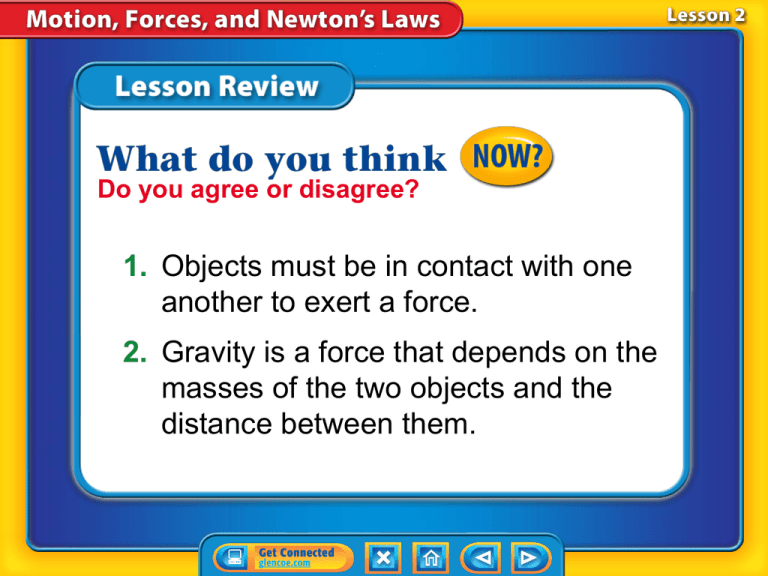
Do you agree or disagree? 1. Objects must be in contact with one another to exert a force. 2. Gravity is a force that depends on the masses of the two objects and the distance between them. Forces • How do different types of forces affect objects? • What factors affect the way gravity acts on objects? • How do balanced and unbalanced forces differ? Forces • force • gravity • contact force • balanced forces • noncontact force • unbalanced forces • friction What are forces? • A push or pull on an object is a force. • A force has both size and direction. • Arrows are used to show the size and direction of the force. • There are two ways a force can affect an object: – A force can change an object’s speed and – the direction in which the object is moving. Types of Forces • A contact force is a push or a pull applied by one object to another object that is touching it. • Contact forces are also called mechanical forces. Steve Cole/Getty Images Types of Forces (cont.) • A force that pushes or pulls an object without touching it is a noncontact force. • Gravity is an example of a noncontact force. Types of Forces (cont.) What is the difference between the way contact and noncontact forces affect objects? Friction • Friction is a contact force that resists the sliding motion between two objects that are touching. • The force of friction acts in the opposite direction of the motion. • Rougher surfaces produce greater friction than smooth surfaces. Gravity • Gravity is a noncontact attractive force that exists between all objects that have mass. • Gravitational force depends on the mass of the objects and the distance between them. Gravity (cont.) • Weight is a measure of the force of gravity acting on an object. • As two objects get farther apart, the gravitational force between the objects decreases. • As the mass of one or both objects increases, the gravitational force between them increases. • Doubling the mass of one of the objects doubles the force of attraction. Gravity (cont.) What factors affect the way gravity acts on objects? Combining Forces • When several forces act on an object, the forces combine to act as a single force. • The sum of the forces acting on an object is called the net force. Combining Forces (cont.) When different forces act on an object in the same direction, you can find the net force by adding the forces together. Combining Forces (cont.) When forces act in opposite directions, you must include the direction of the force when you add them. Combining Forces (cont.) When the net force on an object is 0 N, the forces acting on it are balanced forces. Combining Forces (cont.) If the forces acting on an object are balanced, the object’s motion does not change. • When the net force acting on an object is not 0, the forces acting on the object are unbalanced forces. • Unbalanced forces cause objects to change their motion, or accelerate. Combining Forces (cont.) How do balances and unbalanced forces differ? • Forces are pushes and pulls exerted by objects on each other. Contact forces occur when objects are touching. Noncontact forces act from a distance. • Gravity is a force of attraction between two objects. The amount of gravitational force depends on the mass of the objects and the distance between them. • Balanced forces do not affect motion. Unbalanced forces change motion. Which is a measure of the force of gravity acting on an object? A. friction B. mass C. unbalanced force D. weight Which term refers to the sum of the forces acting on an object? A. friction B. net force C. balanced forces D. unbalanced forces Which force pushes or pulls an object without touching it? A. balanced B. contact C. net D. noncontact Do you agree or disagree? 1. Objects must be in contact with one another to exert a force. 2. Gravity is a force that depends on the masses of the two objects and the distance between them.

